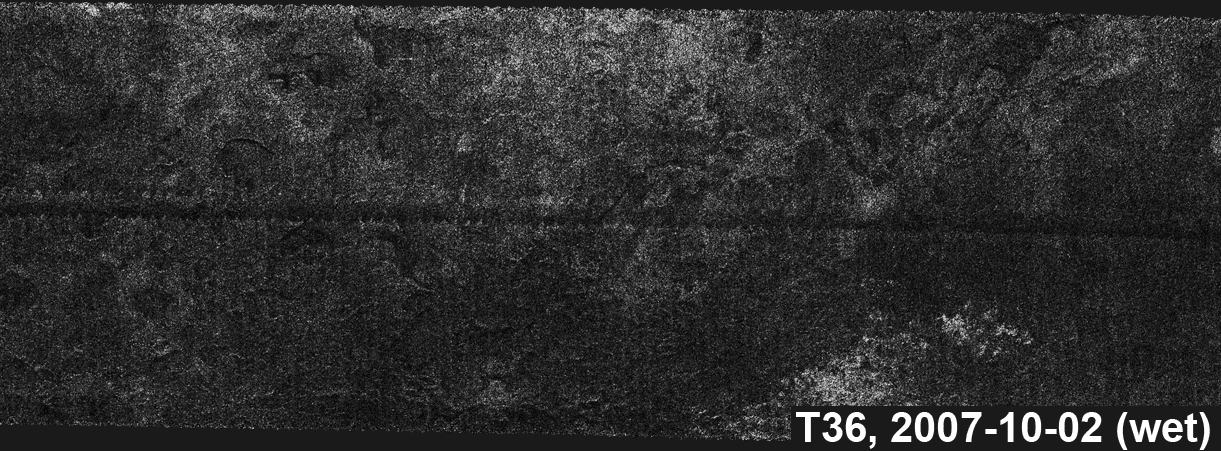Cassini VIMS sees the long-awaited glint off a Titan lake

Written by
Emily Lakdawalla
December 17, 2009
The Cassini mission announced today the first observation of a specular reflection off of a lake on Titan. A specular reflection is a mirror-like flash, and you only get one when you have a mirror-like surface -- very, very smooth. That's hard to do in nature except with a liquid surface (or a surface that froze from a liquid, such as ice and certain types of lava flows). I'll summarize the long road to the specular reflection below, but first, here's the image, certain to become an iconic one of Titan.

Scientists have been hunting for specular reflections off of Titan ever since the notion of liquid hydrocarbons covering some or all of the moon was first proposed by Jonathan Lunine, Dave Stevenson, and Yuk Yung in 1983. (Here's the Science abstract.) Subsequent work (by Caitlin Griffith and coauthors) found evidence for water ice on Titan's surface, suggesting at least that a global methane ocean wasn't likely. In 2003, scientists using the Arecibo radio telescope (a team led by Donald Campbell) reported a "small specular component" to the reflections of radio signals off of Titan and suggested that there may be lakes scattered across the surface.

Cassini finally arrived at the Saturn system in June of 2004, and most of its instruments were designed, in part, with studying Titan in mind. The RADAR instrument, for instance, was included primarily to peer past Titan's haze and map the moon (though of course it uses Cassini's main radio communications dish). The main cameras have numerous filters that are intended specifically for employing skinny "windows" in near-infrared wavelengths where the atmospheric methane is less absorbing to attempt to see the surface. Their vision is far blurrier than the RADAR instrument at Titan, but they can image the whole moon while RADAR just gets skinny strips.
But the real promise for imaging Titan has always been in the Visual and Infrared Mapping Spectrometer, or VIMS -- or at least that's what the VIMS team says! Where ISS (the Imaging Science Subsystem, or main cameras) can only see out to wavelengths of one micron, VIMS can see out to five microns. VIMS has lower spatial resolution than ISS, but it overcomes that deficit at Titan using the longer wavelength, because Titan's atmosphere is much, much, much more transparent at the longer near-infrared wavelengths than it is in the shorter-wavelength windows accessible to ISS.
So. They did both see a landscape of mixed bright and dark terrain that the science team couldn't help but call "continents" and "oceans," but the more they looked, the more they failed to see those telltale specular reflections. And even as Cassini was searching, planetary astronomers (Bob West and coauthors) continued to work from the ground using the latest and greatest adaptive optics technology, and they, too, never saw those glints. Explanations were found for why some specular reflections might be seen at long radio wavelengths but not at shorter optical wavelengths.
Meanwhile, the RADAR instrument was scanning long skinny swaths across Titan's surface, mostly at equatorial latitudes. Their initial results revealed a few enigmatic dark spots that could maybe have something to do with liquids, but more obvious were fields upon fields of "cat scratches," long, linear, dark stripes that were evidently not liquids; researchers quickly decided that they were, in fact, dunes, evidence for the opposite of liquids on Titan. (Here's that abstract, by Ralph Lorenz and coauthors.)

The Huygens landing in January of 2005 showed plenty of evidence for past fluvial activity, but the dark area that the probe landed in seemed as dry as a desert (except for an interesting puff of methane detected after the probe had warmed the ground following its landing, interpreted as possible evidence for methane wetting the ground just beneath the dry surface).

The first possible lake-like feature to be found on Titan was reported from a single ISS image captured very close to the south pole on June 6, 2005, now named Ontario Lacus.

Finally, in July 2006, the RADAR instrument got data over Titan's north pole, and the images were just screaming "lakes"! They looked exactly like what you'd expect lakes to look like, and furthermore were evidently fed by branching networks, river-like features. The discovery was written up in this Nature paper published on January 4, 2007, by Ellen Stofan and coauthors. It became clear that Titan did have lakes, but only near its poles, because local climatic conditions make the rest of Titan too arid.

Interestingly, while RADAR also saw lakes in the south, there were not nearly as many there (at the summer pole) as in the north (the winter pole). Oded Aharonsen and coauthors presented an explanation at the American Geophysical Union meeting a year ago, having to do with "superseasons" on Titan (go nearly to the bottom of that blog entry for my summary); that work was just published a couple of weeks ago in Nature Geoscience.
As compelling as the RADAR images of the lakes were, scientists are happier when there is more than one line of evidence supporting a conclusion, especially when the first line of evidence is morphological -- there are lots of examples of ways that nature can make similar-looking features using dissimilar processes. So the search continued for further evidence for liquid properties and methane-ethane composition in those lakes. Last year the VIMS team looked at spectra from Ontario Lacus and identified the presence of ethane (that was Bob Brown and coauthors). Long-term study of Titan's poles has revealed changes in the appearance of lakes, interpreted to mean that they've dried up under the southern summer sun.

In the end, we don't really need the VIMS specular reflection to be sure there are lakes near Titan's north pole. But I have to say that I am awfully relieved to finally see it, and I wonder if Titan researchers feel the same way. A specular reflection should have been the "smoking gun" for Titan lakes; its absence was deeply puzzling. Now we know that the reason nobody saw it was because the lakes are mostly only found near the north pole. To see a specular reflection from a flat surface near the north pole of a world, you first need to have light shining on it -- and it's been winter in Titan's north since Cassini arrived. Only recently did sunlight start shining on Titan's lake district.
Then, once you have sunlight, the spacecraft has to be in exactly the right place to see a flash. If there were lakes anywhere in the equatorial or temperate latitudes, it wouldn't have been hard for Cassini to spot a specular reflection from them on any of its numerous Titan flybys (of which there have been 64 to date, plus lots of observations from greater distances). But with the flat surface located near the pole, there are only a few situations where the sun-lake-Cassini angle will line up just right to make that glint visible to Cassini's cameras. So, finally, it happened in July. Cassini was practically behind Titan as seen from the Sun; Titan's phase was almost "new" to Cassini. Under that one unique geometry, Cassini finally saw what so many scientists have been looking for for so many years.
Many congratulations to the VIMS team for finally making this observation!
Earth's First Line of Defense
Support the team of astronomers defending Earth with a gift today.
Donate

 Explore Worlds
Explore Worlds Find Life
Find Life Defend Earth
Defend Earth

